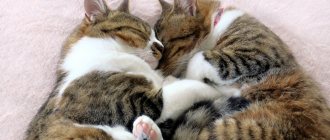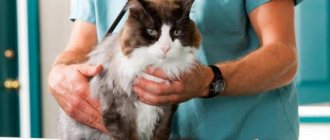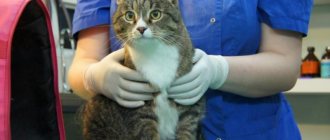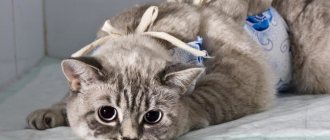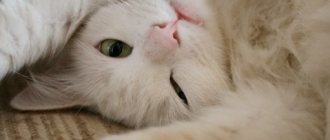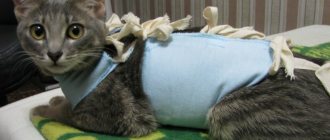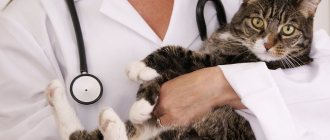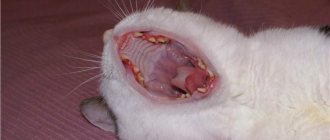Surgery to remove a cat's internal reproductive organs is simple and safe. It relieves the animal of sexual desire, possible pregnancy, and prevents uterine and ovarian cancer. There is a risk of complications. If a cat has a lump on its stomach after sterilization, this may indicate temporary swelling, inflammation and other disorders. It is important to find out what the neoplasm is and why it arose. This will allow you to start treatment on time and protect your pet from negative consequences.
The appearance of a lump: what does it mean?
Note that the appearance of a slight swelling after surgery in itself is quite common and should not be immediately considered a pathology. But this only applies to cases when a couple of days have passed since sterilization. At this time, post-traumatic edema is “relevant”, due to which the swelling is formed.
But in cases where several days have passed since the operation, and the lump still does not seem to resolve, a veterinary examination is necessary.
The statement is also quite true for situations where the tumor somehow bothers the animal, or its size (for example, a tumor the size of an orange) does not allow the swelling to be considered a consequence of post-traumatic edema.
What does it mean? In such cases, we can confidently speak about either a hernia or a serious abscess. Both of these pathologies do not lead to anything good, and therefore they should be eliminated as quickly as possible. However, other reasons are also possible.
Remember! That the animal should in any case be examined by an experienced veterinarian, there is no need to independently engage in diagnostics without having the appropriate knowledge and skills.
The lump is on the seam
So, a lump has formed on the seam. To understand the reasons for its occurrence, you need to evaluate the appearance and size of the tumor:
- It is necessary to palpate the lump and evaluate the texture of its surface, as well as the degree of softness/hardness, the presence or absence of pain in the animal at the time of palpation.
- The size of the tumor is very important. The rule here is simple: the larger it is, the worse the situation is, and the sooner it is necessary to show the pet to the veterinarian.
We list the most likely reasons for the appearance of a lump:
Bacterial contamination of the postoperative suture. It is indicated by increased local and general temperature, redness and soreness of the tissues around the lump. The swelling itself has a hard consistency in the first days, then softens; when palpated, you can feel transfusions and fluctuations of purulent exudate.
If quite a lot of time has passed since the operation, the tumor “ripens”, an abscess appears, and the tumor festers. The process is accompanied by copious discharge of purulent exudate.
Cones of bacterial origin are very dangerous, as sepsis can develop at any time. One of the distinctive signs of an “abscess tumor” can be considered its rapid development: often the lump appears within three or four days from the moment of the operation.
It happens that when removing stitches, the veterinarian (or the owner himself) leaves one or a couple of loops in the skin. As a rule, there is nothing wrong with this, but sometimes such forgetfulness results in the growth of a connective tissue capsule on the loops.
This nature of the pathology is indicated by the high density and even rigidity of the tumor (it is very hard to the touch, the texture resembles a piece of wood), as well as its long development. As a rule, such bumps may appear on the suture line no earlier than a couple of weeks after surgery.
Sometimes swelling on the suture line is a consequence of individual intolerance to the drugs used either during anesthesia, or during the preparation of the surgical surface immediately before surgery.
Simply put, swelling is a consequence of an allergic reaction. An allergic etiology is indicated by severe (and sometimes painful) itching, as a result of which the animal, even without really recovering from anesthesia, constantly tries to scratch its belly, or even frantically gnaws at it.
If the lump has formed under the seam
Note that in this case the pathology is much more dangerous. If the appearance of a lump is due to the same purulent inflammation, and the swelling itself is a classic abscess, then it can “explode” at any moment. The cat, accordingly, will most likely die from peritonitis.
The examination of your pet should be approached with the utmost care and utmost caution:
- It is necessary to carefully feel the seam line, avoiding strong pressure. An alarming sign is pain, as well as swelling and redness of the external tissues. If the suture directly above or near the lump is inflamed and noticeably swollen, you should inform your veterinarian as soon as possible.
- The general condition of the animal is of great importance. If the cat is lethargic and refuses food and food, then it must be taken to the clinic immediately. Such signs never mean anything good.
The reasons are almost the same as in the previous case, but there are several features:
- If there is a lump under the stitch, then it may well be a hematoma. However, distinguishing it from an abscess based on indirect signs is not an easy task. As a rule, with a hematoma, the local body temperature in this place remains normal, and pain is usually not observed.
Remember! You should feel the suture line as carefully and delicately as possible, as there is a risk that the hematoma (or abscess) will burst, which will lead to new problems.
- The lump may be an abscess. It is formed only when during the operation the basic rules of asepsis and antisepsis were very grossly violated.
- An ordinary bruise. In cats, after surgery, coordination of movements (due to general anesthesia) is often severely impaired. It should be taken into account that with strong impacts, bumps often appear under the skin, and not deep in the seam. Their appearance can be associated with both traumatic edema and hematomas.
- A hernia is the most serious cause of a lump appearing directly below the suture line. And even an owner with minimal experience can identify it. The tumor in such cases is very soft, voluminous, and in the thickness of the hernial sac (in the most severe situations) the intestinal loops can be easily felt. If these signs are detected, the animal must be immediately taken to the clinic, since hernias are easily strangulated, and they lead to intestinal necrosis, fecal peritonitis and other pathologies, often resulting in the death of cats.
Inflammation of the common vaginal lining
A fairly common phenomenon that occurs due to:
- shell detachment;
- administering too much novocaine;
- improper incision of the scrotum;
- blood clots remained after the operation;
- dirt ingress;
- burn of the shell with an alcoholic antiseptic solution.
If you cut the tunica vaginalis to insufficient length, it will not extend upward. The drooping sheets of the membrane form connective tissue adhesions, inside which exudate accumulates. If there is no infection in the cavity, the exudate will resolve on its own after some time. But when bacteria penetrate, purulent inflammation occurs.
Signs of an inflammatory reaction are as follows:
- swelling of the scrotum;
- temperature increase by 1-2°C;
- increased level of neutrophil leukocytes;
- weakness, lethargy, the animal refuses food;
- soreness of the scrotum;
- when palpating, a fluctuation is heard;
- a small amount of purulent exudate may be released;
- the pus is semi-liquid, yellowish, containing fibrin;
- when the adhesion ruptures, exudate comes out in large quantities.
For treatment, surgical opening of the adhesions ; after removing the exudate, the pain is eliminated, the temperature drops, and the animal quickly returns to normal. The scrotal cavity is treated with antiseptics (3% hydrogen peroxide solution). At high temperatures, antibiotics can be prescribed.
What to do: first aid and elimination of pathology
In all of the above cases, we would advise you to first contact a veterinarian. Even when the lump is on the surface of the seam, it can be dangerous to the health and even the life of the animal.
Lump on the seam
Everything is quite simple here:
- If the lump festers, the local and general temperature is elevated within three days after the operation, and the site of the swelling hurts more and more (which is easy to determine by palpation), then there is only one way out - an immediate visit to the veterinarian.
- The owner will not be able to cope with purulent infections after surgery on his own.
- If you suspect the formation of a connective tissue sheath around sutures forgotten during removal, the approach is the same. Visit to the veterinarian. The pathology is not particularly dangerous, but can only be eliminated surgically.
- Finally, drug intolerance and allergic reactions. At home, you can give your cat about half or ¼ of a diphenhydramine tablet, but in cases accompanied by severe itching, we would also advise calling a veterinarian immediately.
Lump under the seam
Often the reasons for the formation of a tumor in these cases are more serious, and therefore in any case you will have to contact a veterinarian. There are, of course, some nuances:
- If a hematoma is suspected, cold can be applied to the abdomen for 10-15 minutes. Low temperature helps to compress blood vessels, which reduces the intensity of pain. The same can be done for purulent inflammations, but in any case, the cat must be shown to a veterinarian. If the animal has a very high local or general body temperature, you should not delay a visit to a specialist.
- Cold also helps with bruises, and heat (warm lotions) on the second day. The problem is that when falling, the cat could receive not only bruises, but also more severe injuries, the consequences of which often manifest themselves later.
Formation of a hernial sac = immediate visit to the veterinarian. The hernia cannot be eliminated at home; delay is fraught with compression and necrosis of the intestinal loops.
Healing time
On average, a scar is formed in an animal for about a week.
If there are no complications after sterilization, the sutures heal on average in 5-7 days. However, recovery time largely depends on the individual characteristics of the animal’s body. In cats that are spayed at an older age, healing may take 7-10 days. If the owner does not pay attention to treating the incision, and the pet constantly licks the wound, then healing takes weeks. Removal of sutures after surgery in cats, provided there are no complications, is carried out on the 10th day. Trying to remove stitches yourself is strictly prohibited. Unprofessional manipulations will entail a lot of negative consequences, under the influence of which the animal may even die.
Prevention
In many cases, the bump is the “handiwork” of the owner himself. More precisely, the result of his failure to comply with the basic recommendations of the veterinarian.
Accordingly, prevention is quite simple:
- For 12 hours before surgery and the same amount after it, you cannot feed the animal. Neglecting this rule can lead to the formation of a hernia.
- After anesthesia, the cat's coordination of movements is significantly impaired. There is no need to place it on a bed or ottoman. The ideal option is a separate basket in an isolated room.
- If the animal is overly active and constantly tries to scratch or lick the seam, it is necessary to put a surgical collar on it.
Failure to follow these rules is the main reason why a cat develops a lump after sterilization.
Nowadays, more and more cat owners are turning to the help of a veterinarian to castrate their pet. After all, when a funny, playful baby grows up, his behavior changes: he becomes restless, noisy, marks his territory and tries to run away from home. After castration - surgical removal of the sex glands, a cat becomes calm and peaceful, signs of sexual behavior disappear. This operation is simple and short-term, but owners must prepare for proper care of the animal in the postoperative period.
Medicinal support
Painkillers:
- Rimadyl (carprofen) – intravenously or subcutaneously at a dose of 4 mg/kg (equivalent to 1 ml/12.5 kg of weight) once a day;
- Tolfedine (tolfenamic acid) – 4 mg/kg once a day orally with food;
- Ketofen 1% (ketoprofen) – subcutaneously, intramuscularly or intravenously at a dose of 2 mg/kg (or 0.2 ml/kg) once a day and no longer than 3-4 days;
- Loxicom (meloxicam) – 0.1 mg suspension/kg orally on the first day once, 0.05 mg/kg on subsequent days.
Seam treatment products:
- Chlorhexidine 0.05% (aqueous solution) - water the seam through a dispenser or drip from above using a pipette until healing;
- Dioxidine 0.5% - use similarly to Chlohexidine;
- Veteritsin spray - spray the suture area 1-2 times a day before removal;
- Aluminum spray - spray on the seam every few days until healing;
- Chemi spray - treat the seam once a day until healing;
- Levomekol ointment - apply around the wound once a day, under a bandage.
Antibiotics:
- Sinulox (amoxicillin + clavulanic acid) – intramuscularly once a day at a dose of 0.5 ml/10 kg for 3-5 days;
- Amoxicillin 15% - subcutaneously or intramuscularly 1 ml/kg (in terms of 15 mg/kg) once for 5 days.
General strengthening drugs:
- Gamavit - the first 2-3 days at a dose of 0.5 ml/kg of body weight, then up to two weeks at a dose of 0.1 mg/kg.
Hemostatic agents:
- Travmatin - intramuscularly or subcutaneously 0.5-1 ml 2-5 times a day;
- Etamsylate – 0.1 ml/kg twice a day.
Care
The cat sterilization operation is performed under general anesthesia. Before surgery, the animal is examined, breathing and heartbeat are listened to. It is better to castrate a young animal from 6-7 months, then the recovery will be much faster and painless. If possible, choose a non-summer time for the procedure to reduce the risk of postoperative wound infection.
Anesthesia
The first few hours after castration, the cat is under the influence of anesthesia, and therefore especially needs your care and attention. It is impossible to say exactly how long it will take your pet to recover and how he will endure this period. One cat sleeps for a long time, making the owners worry, and after a couple of hours the other is confidently on his feet. The main recommendations are:
1 place the cat on a flat surface, preferably on the floor or a spacious basket covered with oilcloth and a warm diaper. Cover him with a blanket, you can put a heating pad on the back; during anesthesia, thermoregulation is impaired and it is necessary to warm the cat; The cat's eyes will be open, despite sleep, so close them once every half hour, gently massage through the eyelids to avoid dryness of the cornea; Regularly turn the animal from one side to the other, control breathing and body temperature. 4After anesthesia, the cat often experiences dizziness and disorientation, so protect against falls from heights and bruises: 5Place a tray in the room without filler or with soft, light filler. If your pet is bleeding, you will notice it in time. 6Provide access to fresh water, because the cat will be very thirsty. Offer him to eat no earlier than after 6 hours, although he may not have an appetite for a longer time. If the cat does not eat after castration, do not worry, some pets need at least a day to feel the desire to eat again. Let the first food be low-fat kefir, light broth, cottage cheese. 7Anesthesia after castration affects the cat’s psyche, making it fearful and unbalanced. Protect the mustachioed from stress with a calm and caring attitude. Do not punish in case of involuntary urination, this is one of the consequences of anesthesia.
Treatment and care of the wound
As a rule, pets who have come to their senses begin to take an active interest in the postoperative wound and lick it. You need to treat the seams with disinfectants: rinse with hydrogen peroxide once or twice a day, lubricate with brilliant green. And, of course, do not allow the cat to lick the wound to avoid infection. During warmer months, your veterinarian will recommend a course of antibiotics. And if a cat prevents the wound from healing after castration, he is given a special collar. These days, use a soft, light-colored litter on the tray to prevent it from scratching the wound and to make possible blood stains easier to see.
Dietary changes
For the first few days, the cat needs its usual food, since it doesn’t need any extra stress now. Subsequently, make his diet less high in calories and carbohydrates, because a male who has lost interest in the opposite sex no longer requires as much energy. But this does not mean at all that the cat will now only eat and sleep. Pay attention to food created specifically for castrated cats. Due to the fact that their metabolism slows down and also undergoes chemical changes, exclude sausage and fish from the cat's menu. Now their use can lead to urolithiasis in your pet, a dangerous complication after castration.
Complications
In most cases, animals tolerate the operation quite easily, and within 1-3 days they recover: the cat again begins to eat, drink, play, in general, enjoy life as before. If, a few days after castration, your cat looks restless and depressed, does not eat or drink, or, on the contrary, drinks a lot, does not have stool for several days or has black, tarry stool, and rarely urinates, this is a serious reason to consult a doctor!
Possible complications during castration of cats:
Pain after castration. A fairly common symptom, because the intervention is carried out on a very sensitive area of the cat’s body. An animal that is bothered by pain may hide in a secluded corner, tremble, move restlessly, hiss and bite when trying to pick it up. If you think your cat is in pain, ask your veterinarian to prescribe special pain medications. Do not self-medicate, because some medications for humans are toxic to cats!
The appearance of tumors, hematomas, filling of the scrotum with blood after castration. In the postoperative period, it most often occurs either during increased physical activity (the cat runs or jumps a lot), or when licking a surgical suture, as well as in large adult cats, whose blood vessels are large and more prone to bleeding. In most cases, swelling and inflammation go away on their own; keep your pet at rest and prevent licking the stitches.
Infection of sutures after castration. It occurs rarely, mainly due to poor care of the operated animal. Inflammation, redness, soreness appear in the suture area, and the temperature may rise. To prevent this complication, for a week after surgery, do not allow the cat to walk outside where dirt and bacteria can get into the wound, do not allow the sutures to be licked, do not bathe it, and also make sure that the cat’s feces do not contaminate the wound. This problem requires examination by a veterinarian to prescribe antibiotic therapy.
Features of life:
When all the hardships of rehabilitation are over and the cat has regained its former vigor and appetite, take care of the cat’s balanced diet; he will no longer be interested in the neighbor’s cat, but in food! If you feed your pet dry food, do not forget about the constant availability of fresh water. Help your cat move and play enough so that he is slim and strong as before.
Owners notice changes in the cat’s behavior within a week after castration: he becomes affectionate and calm. playful, stops marking corners. But sometimes even a neutered cat marks its territory. Why does this happen, and what can you do to eliminate this behavior? Here are some reasons for this:
The cat turned out to be a cryptorchid, that is, one testicle is located not in the scrotum, but in the abdominal cavity, continuing to produce sex hormones and cause all manifestations of sexual activity in the male. In this case, an additional abdominal operation is needed to remove the remaining gland.
The cat is already an adult, and he has formed the habit of marking his territory at the reflex level. It is recommended to use special aerosols that eliminate odor and thus reduce the desire to mark.
There are other cats in the house, and the neutered cat continues to compete with them, leaving his marks.
You have a new family member, and the cat will definitely want to mark the entire territory, showing “who’s boss.” Consult a zoopsychologist, he will advise you on how to change the behavioral reactions of your mustachioed friend.
In our veterinary office, we recommend that the planned procedure for castration of a cat be carried out at the client’s home. You can make an appointment and find out the price of the operation by phone, and also receive a free consultation with a veterinarian on the preoperative preparation of the animal. The advantages of performing an operation at home are obvious: you choose a time that is convenient for you, without losing it in line at the clinic. The pet is in familiar home conditions, without experiencing additional stress and the risk of becoming infected with other people's germs. Our specialists will bring with them all the necessary equipment and medications, create safe sterile conditions for the operation, remove the animal from anesthesia and accompany the animal’s rehabilitation process until full recovery.
Why is pulmonary edema dangerous in cats: causes of pathology
Due to the similarity in the structure of the internal organs of animals belonging to the class of mammals, all its representatives tend to develop similar diseases in the same situations. Pulmonary edema in a cat develops according to characteristic mechanisms; it is important to pay attention to the symptoms of the disease in a timely manner.
Main causes of pathology
Pulmonary edema occurs due to circulatory failure in the systemic circle. The pumping function of the heart suffers, the entire volume of fluid cannot pass through the vessels, and stagnation occurs in the lung tissue. Through the lumen of the arteries, foamy exudate enters the alveoli, the smallest structures of the lungs. This reduces tidal volume, which if left untreated, leads to death.
The causes of the pathology may be:
- high blood pressure;
- increased vascular permeability.
Sterilization is often recommended for animals in their first year of life. Pulmonary edema occurs periodically in cats after castration, which is associated with a reaction to anesthesia. If the animal is not examined before surgery, then the tolerability of the drug in the presence of a chronic disease is not taken into account.
The drug provokes circulatory problems. Signs of pathology often appear after anesthesia, after a few days. Therefore, it is difficult to determine the relationship between the condition and anesthesia.
Types of edema
Depending on the cause of the disorder, pulmonary edema is divided into 2 types:
- cardiogenic;
- not associated with cardiac pathology.
Due to the differences in the factors of occurrence, despite the similarity of their manifestations, the therapy for these types of edema is different. The first category includes chronic disorders of the cardiovascular system that arise due to:
- heart defects, congenital and acquired;
- cardiosclerosis;
- blockage of blood vessels with blood clots;
- hypertension.
Non-cardiogenic edema results from damage to the lung tissue or pathology of other organs and systems, for example:
- respiratory tract burn;
- poisoning with toxic substances;
- inflammation caused by bacterial and viral infections;
- kidney pathology;
- traumatic brain injury;
- electric shock;
- allergy;
- malignant tumors;
- snake bite;
- anorexia;
- blood poisoning;
- starvation;
- disruption of the gastrointestinal tract (liver disease).
External symptoms
Signs of pathology increase quickly, over several hours.
You can suspect that edema is developing in the lungs if the following signs appear:
- sudden increase in shortness of breath;
- listening to wheezing during inspiration during auscultation;
- the appearance of a bluish tint on visible mucous membranes;
- foaming from the mouth and nose;
- at the initial stage - the development of hyperthermia, then a decrease in temperature.
Even before a clear clinical picture appears, the owner should pay attention to the lack of appetite, anxiety or apathy of the animal. The cat may stick out its tongue, breathe rapidly, or cough up clear or bloody foam.
How is pathology diagnosed?
The disorder can be determined using physical, instrumental and laboratory research methods. After examining the animal and listening to the lungs and heart, the doctor can immediately guess the cause of the disorder.
Moist rales are heard in the lungs using a phonendoscope. X-ray helps to see a decrease in the lung space and a change in the heart shadow.
If the cause is hypertrophy of the left heart, then on an ultrasound the doctor sees congestion in the aorta and an increase in the volume of the left ventricle. Signs of the pathological process will also be visible in blood and urine tests. Investigations will help identify the cause of the swelling.
First aid in case of serious condition
In case of swelling of the lungs, it is necessary to urgently remove excess fluid from the organ. A number of measures are used for this:
- a diuretic solution is administered parenterally;
- the cat cannot be laid down, it must be supported in a vertical or semi-vertical position;
- carry out oxygenation through a mask to ensure oxygen supply to the tissues;
- give painkillers;
- using an intravenous system, vasodilators are administered to reduce the amount of fluid entering the lungs;
- if the cat cannot breathe on its own, the trachea is intubated and transferred to artificial ventilation.
How veterinarians reduce swelling
Before starting therapy, the doctor identifies the severity of symptoms and prescribes treatment in accordance with the data obtained. Medicines used for emergency care are included in further treatment regimens.
Anti-inflammatory drugs of a hormonal nature, as well as bronchodilators, are prescribed. Despite the fact that inflammation is eliminated and the bronchi dilate, other groups of drugs are also prescribed in the treatment of this pathology.
To stop the progression of edema, it is necessary to eliminate its cause. Whether the disease can be cured depends on the extent of the process and how quickly the owner sought help. Intensive therapy is necessary for the cat for 24-72 hours.
An objective sign of elimination of edema is a decrease in symptoms of the disease in combination with an improvement in laboratory parameters and an increase in lung volume on an x-ray.
Further forecast
The animal's chances of survival depend on the type of swelling. If the cause is cardiogenic, the prognosis is less favorable. With chronic heart disease, the cat has few resources to restore its health; the help of a doctor is necessary.
If the cause is non-cardiogenic, then eliminating the foam flow will allow the heart to function without impairment. The prognosis is favorable if the swelling has not become extensive.
After completing the course of therapy, consequences may appear. These may be complications in the form of sclerosis of the lung tissue, pneumonia and collapse of the alveoli.
Disease prevention
In order not to face the question of how a cat can survive pulmonary edema, you need to follow preventive measures. Obesity is a factor in many chronic processes.
Therefore, it is necessary to feed the animal according to its needs. The diet should consist of an optimal ratio of different groups of substances.
Artificially bred cat breeds are more susceptible to chronic heart disease. Therefore, it is necessary to periodically examine the animal.
Source: https://vsekotiki.ru/zdorove/simptomy-oteka-legkih-u-kota
swelling of the scrotum after castration of a cat
Hello again, I’m asking for advice, because I don’t know what to do anymore. We went to the doctor who castrated our cat, he looked at the swollen scrotum and said that the cat licked the wounds and this happens, he told us not to do anything, to smear it with levomekol and it will go away on its own, he didn’t prescribe any antibiotics and generally treated us as if we were there every day We get him out of nothing. I applied levomekol every day, the swelling subsided literally the next day, the only antibiotic I could find at home was flemoxin in tablets (pharmacies don’t want to sell it without a prescription), I give it with food according to the instructions for children under 3 years old, 2 times a day, once on the day of the wound I sprinkle it with tetracilin (powder), the collar is always on, it is removed only for feeding, I recently noticed that pus was coming out of one wound, I tried to squeeze it out, it didn’t work, there was something thick inside (there is no such thing in the second wound), I washed it with peroxide and now I don’t know what else needs to be done, I don’t want to go to the doctor, he will again say that this is all normal and nothing needs to be done, tell me what to do, I will do everything that needs to be done, even if I’m all bitten and scratched for it
In what cases is it necessary to contact a veterinarian?
The recovery process after surgery is usually easy and lasts about a week. Slight changes in behavior, redness, and swelling in the genital area are considered normal. The “patient” needs to be monitored; if the condition worsens, consult a doctor.
Abnormal postoperative manifestations:
- continuous bleeding;
- the pet is in severe pain and meows loudly;
- severe swelling and redness in the operated area;
- complete refusal of food, even your favorite canned food;
- high temperature, accompanied by trembling and thirst.
It is strictly forbidden to carry out independent therapeutic measures. This threatens to worsen your health.
Prevention
In many cases, the bump is the “handiwork” of the owner himself. More precisely, the result of his failure to comply with the basic recommendations of the veterinarian.
Accordingly, prevention is quite simple:
- For 12 hours before surgery and the same amount after it, you cannot feed the animal. Neglecting this rule can lead to the formation of a hernia.
- After anesthesia, the cat's coordination of movements is significantly impaired. There is no need to place it on a bed or ottoman. The ideal option is a separate basket in an isolated room.
- If the animal is overly active and constantly tries to scratch or lick the seam, it is necessary to put a surgical collar on it.
Failure to follow these rules is the main reason why a cat develops a lump after sterilization.
If you have an affectionate fluffy cat in your home, then you should be prepared for the fact that a little time will pass and the animal will begin to show its natural instincts. And then sleepless nights with loud meowing await you. Your pet will become disobedient and may refuse to eat or drink. The cat will always ask to go outside, and if she manages to escape, then after a while she will bring you her offspring: kittens, which will have to be given to someone. To avoid all these problems, there is a completely humane way -.
This surgery occurs without complications in most cases. However, sometimes after spaying a cat may develop a lump on its belly.
The cat has a lump on its stomach - what is it?
Such lumps on the abdomen under the suture, which appeared in, can sometimes be a postoperative hernia. In this case, the sutures separate, the internal organ, most often the intestinal loop or omentum, protrudes, and a lump forms on the surface of the abdomen. A distinctive feature of a hernia is that such a lump will be soft to the touch and easily disappear even with light pressure. This postoperative complication requires mandatory consultation with a specialist, since strangulation of the hernia is possible. And if such a lump bothers the cat, then a repeat operation is necessary to remove the lump on the stomach.
Sometimes bumps can appear in the suture area due to the tissue healing characteristics of that particular animal. This phenomenon is postoperative swelling or proliferation of granulation tissue. In this case, it is not a pathology, and such bumps disappear about a month after the operation.
If there is no inflammation at the site of the bulge, then the cause of its appearance may be the rapid resorption of the suture material, that is, if the suture is not completely healed, the thread disappears and a lump forms in this place. Perhaps the cat behaved very restlessly after the operation, and this caused the appearance of a lump on its stomach. In addition, such a postoperative complication can arise as a result of a violation of the suturing technique by the veterinarian.
To prevent bumps from appearing after spay surgery, you must carefully follow your veterinarian's recommendations for caring for your cat. In the first few days, you need to limit your pet’s mobility and prevent it from getting hypothermic. The postoperative wrap should not be removed before the permitted period. As a last resort, you can put a special collar on the cat, which will prevent the seam from licking.
Sterilization is a forced procedure for cats from which it is not planned to produce offspring. Unfortunately, it does not always go smoothly; after all, it is a surgical intervention. In some cases, after sterilization, a cat will develop a lump on its stomach.
This postoperative complication usually frightens owners, since associations with malignant tumors involuntarily arise. Let's look at what to do if lumps appear on your pet's belly.
Experts define a lump on a pet’s belly that appears near the suture as a postoperative hernia (a complication of sterilization). Unlike a regular tumor, it is a convex sac formed due to protrusion of skin tissue around the suture. This occurs due to prolonged damage to the edges of the wound.
Unfortunately, a hernia is not the only problem that can appear after sterilization.
Let's look at the main types of tumors that can appear on the abdomen of cats:
| Type of compaction (bumps) | Localization location | Is there pain syndrome? | Main external signs of seals | Signs of purulent contents |
| Hernia seal after sterilization | On the stomach, in the seam area | No pain | The lump is soft to the touch, disappears when pressed (pressed inward) | None |
| Swelling of the mammary glands after sterilization | Multiple lumps around the nipples | Appears with the development of mastitis | Dense, rough | Can be |
| Lymphadenitis | At the location of the lymph node | When palpated, the animal feels pain | Dense, hot | Can be |
| Abscess | At the site of infection | Yes, I have | Red, has a whitish area in the center of the lump (purulent cavity) | Eat |
| Tumor (benign or malignant) | Unlike a postoperative hernia, it is characterized by slow growth | Not always, especially in the early stages | Dense, does not disappear when pressed, has clear boundaries | Can be |
Signs of an inflammatory process (hot skin around the seal, increased body temperature, etc.) are absent only in the case of a hernial seal after sterilization. If you notice them or the suture is swollen, or a lump appears on the cat’s stomach, in order not to risk it, it is recommended to immediately show your pet to the veterinarian. The specialist will immediately determine the type of tumor and prescribe the necessary treatment.
Tissue loss
For example, the omentum, a section of the intestine, the common tunica vaginalis, the stump of the spermatic cord. A fairly rare complication in cats due to the narrowness of the inguinal ring.
Occurs in several cases:
- with an enlarged inguinal ring;
- with strong compression of the abdomen during surgery;
- in case of damage to the inguinal ring (rupture of muscles, ligaments, fractures);
- detachment or degenerative and sclerotic changes in the common vaginal tunica;
- tension of the spermatic cord when applying a ligature;
- low ligature application on the spermatic cord;
- incorrect incision of the scrotum.
Loss of tissue is determined by the presence of an abnormal formation after castration. The hernia can be in the form of a sphere, flap, or cord. In this case, the fallen part of the tissue becomes dirty and infected with the development of purulent processes, edema and hyperemia. When the omentum, spermatic cord or common tunica vaginalis prolapses, the animal does not show concern due to the absence of nerves in these tissues.
But when a section of the intestine prolapses, the pet exhibits a strong pain reaction (colic). In this case, the inflammation spreads to other parts of the intestine and the mesentery, eventually developing peritonitis, the symptoms of which are fever, tachycardia, rapid breathing with depression of the general condition.
Treatment is only surgical. The prolapsed part of the common vaginal membrane or spermatic cord can simply be cut off. The omentum must be set back; if necrosis is observed on it, then the area must be separated with a ligature and cut off.
Intestinal loops should also be straightened, and necrotic areas should be cut off. In this case, it is necessary that the intestine be intact and airtight, so when excision it is carefully sutured. After tissue reduction, the inguinal ring is sutured.
What to do if a lump appears
If a hernia (bump) appears on a cat’s abdomen after sterilization, a repeat operation is necessary. If the case is simple, you will only need to stitch it again. If the process is advanced, more extensive intervention will be required.
Typically, postoperative hernias disappear a month after reoperation. During the recovery period, it is necessary to provide the pet with proper care. A lump on the abdomen can also appear as a result of the process of growth of “young” skin, in this case it goes away on its own within 1-1.5 months.
A cat in the house means not only happy moments of playing with a pet, but also caring for natural instincts, which will soon wake up and loudly declare themselves. Many owners resort to sterilization of pets, helping to neutralize instincts and at the same time preserve the health of the animal.
The operation is simple, and the recovery period is quick, in most cases without complications. But if a lump on your cat’s stomach begins to cause suspicion after sterilization, do not delay your visit to the veterinarian. What this swelling could be - read below.
What to do if the wound does not heal?
A cat owner may face unpredictable consequences, one of which is a non-healing wound.
The problem may arise due to one of the complications. A question like this always requires consultation with a veterinarian. You need to call the clinic or meet with the doctor in person and show him your pet.
The doctor will accurately determine the cause of the lack of healing and help solve the problem.
Important!
Under no circumstances should you ignore a non-healing wound or try to treat the animal yourself. This can not only delay recovery time, but also harm the pet.
Development of a hernia after sterilization
A hernia in a cat after sterilization acts as a reaction of the body to the divergence of the subcutaneous sutures. In this case, it is necessary to conduct a veterinary examination, since outwardly the incision site may remain intact, with the presence of intact threads, but a seal will be palpable on the side. This may be due to premature delamination of the surgical material with which the wound was sutured after sterilization.
A lump can also form due to medical negligence, when the correct operating technique is violated.
To rule out other symptoms, carefully examine the swelling. It will be soft to the touch and quickly disappear with light pressure, since it is formed from an intestinal loop or omentum. If the lump bothers your cat, try to show your pet to a specialist as soon as possible, eliminating the consequences of a strangulated hernia. In this case, surgical intervention to remove the formation will be required.
Sometimes swellings, very similar to bumps, can form in the area of the healing seam due to swelling or due to the growth of internal tissue during the healing process. Such bumps are not pathological cases and resolve within a month from the moment of sterilization.
Bleeding
This may occur due to several factors:
- insufficient ligation of the spermatic cord stump;
- when the bandaging is too strong, when additional damage occurs;
- poor quality ligature;
- flabbiness of blood vessels, which causes them to rupture;
- low blood clotting;
- varicose veins of the spermatic vein.
Bleeding from the skin of the scrotum is not a complication . This is a normal reaction of damaged tissue. Such hemorrhage is not profuse, the blood flows drop by drop, quickly coagulates, so that it goes away half an hour after castration.
Important! A complication is bleeding from the vessels of the spermatic cord, vas deferens or scrotum.
In this case, the blood flows in a trickle, often small, but sometimes extremely powerful, it all depends on which artery or vein was damaged.
Symptoms. Bleeding can be detected by characteristic traces of blood. In severe cases, anemia, weakness, tachycardia, and the development of shock are added to the symptoms. Sometimes the bleeding becomes internal, so it is detected by pale skin, weakness, and accumulation of blood in the abdominal cavity.
Treatment is only surgical. A repeated resection is performed, the damaged vessel is found, a ligature is applied or it is sutured. To eliminate the symptoms of anemia, you can administer calcium chloride and prescribe iron-containing medications. In severe cases, a blood transfusion is required.
Preventive measures
To prevent a cat from growing a lump on its stomach after sterilization, it is important to follow simple rules for caring for your pet. Be sure to use alcohol wipes for disinfection, bactericidal ointment and lotion when treating the seam. As soon as the cat begins to recover from anesthesia after the operation, it is necessary to put a blanket on it and strictly ensure that the animal does not try to get rid of the “outfit” and expose the seam.
Provide your pet with clean water and place the bowl next to the bed, not allowing him to move around too much during the first day after sterilization. You can feed the animal only on the second day; on the first you can treat it only with a small amount of milk. For successful recovery, feed your cat with vitamins and give an antibiotic, but only with a doctor’s prescription. If all recommendations are followed, the animal will fully recover within 1-2 months.
If a cat develops a lump on its abdomen after sterilization and does not go away after a month, repeated intervention will be required.
Most likely, a process of suppuration has begun at the site of the incision, requiring immediate removal of the sutures. An infection may be indicated by a lethargic, apathetic state of the pet and lack of appetite. To prevent complications, observe hygiene requirements and provide your pet with comfortable conditions for postoperative recovery.
Vet
What does the seam look like?
Sterilization is a surgical operation that involves complete or partial removal of the reproductive system organs of a cat. For cats, surgery is called castration. After castration and sterilization, careful treatment of the suture is required, which will help prevent inflammation, suppuration, and speed up healing. With proper care, the scar becomes invisible.
With any method of sterilization, stitches are placed on the wound, which can be on the stomach or side. Rarely is the incision sutured with catgut; self-absorbable synthetic threads are more often used. Sutures after sterilization of a cat are applied in two ways:
Self-absorbable threads can be used to suture the wound.
- Classical. Special threads are used that do not dissolve - nylon, silk. Depending on the type of sterilization, a continuous or interrupted suture is formed.
- Interrupted or continuous intradermal suture. Absorbable threads are used as suture material. There is no need to remove the internal seams.
A self-absorbing internal cosmetic suture is recommended for homeless cats for which regular care is impossible. In addition, the wound is sutured using this method for overly aggressive pets, who, under any pretext, do not allow the owner to treat and bandage the wound.
Aspiration pneumonia
In almost all cases when this pathology develops, either the owners who fed their pets before surgery or the cats themselves, who managed to eat a few hours before sterilization, are to blame for its appearance.
It is for this reason that experienced veterinarians prefer to lavage the stomach of their patients. The pathology is severe and often leads to death.
Causes
In general, we have already mentioned most of the predisposing factors:
- Feeding less than 12 hours before surgery.
- Watering a couple of hours before sterilization.
- The most unappetizing reason is the penetration of worms into the lumen of the lungs. This happens when the owners of the animal did not carry out antiparasitic treatments at all.
How to distinguish from enlarged mammary glands?
One of the most common types of complications is a change in the size of the mammary glands. They can simply swell. This symptom is called false pregnancy. If a cat's mammary glands are swollen, this means that the process began even before the operation. Removing the ovaries could not stop their enlargement.
After surgery, the glands may become enlarged due to stress. In case of false pregnancy, you need to help your pet’s body reduce the level of lactation. So, to correct the functioning of the glands, you need to reduce the consumption of carbohydrate-containing and dairy products. Enlargement of the glands can go away on its own, however, sometimes there is a chance that mastitis will appear. In any case, if the glands are swollen, the pet should be taken to the clinic.
In addition to postoperative hernia, lumps resulting from swelling of the mammary glands are also considered a complication of sterilization of cats. This occurs as a result of natural hormonal changes after removal of the ovaries, or the operation was done early in pregnancy. These seals differ according to the place of formation: the hernia is localized in the suture area, and the seals of the mammary glands are located around the nipples.
A hernia, as a rule, manifests itself in the form of a single compaction, while breast tumors are multiple - their number depends on the spread of the pathological process and the coverage of the lobules of the gland. If a cat has multiple lumps on its stomach, then this is most likely not a hernia.
In both cases, the process is usually painless. But this does not mean that you do not need to go to the doctor: consultation with a specialist is mandatory. A postoperative hernia can be complicated by pinching of internal organs and the development of extensive infection and blood poisoning. And engorgement of the mammary glands is often complicated by mastitis and requires the exclusion of cancer.
Constipation
If everywhere is clean, but the cat's tray is still empty, you should pay attention to the behavior and general condition of the pet. Constipation in cats after surgery can be very painful. The cat takes a pose characteristic of symptoms of constipation: the animal screams pitifully, the tail trembles. If you experience constipation after surgery, you should not use any laxatives without consulting a doctor. You can help with constipation by giving your animal one tablespoon of Vaseline oil.
It is perfectly absorbed by the body and does not harm the general condition of the animal at all. For constipation after surgery, this drug can be given three times a day. You need to take a syringe without a needle and inject the mixture into the cat’s cheek. If constipation does not go away after 24 hours, be sure to call the veterinarian. An experienced specialist, after an examination and x-ray, ultrasound, will be able to tell you how to cure constipation in a cat after sterilization.
Sometimes a regular enema can help a cat much more than a laxative for constipation. However, such manipulations must be done by a doctor. In most cases, constipation after sterilization can be eliminated by creating a special diet and prescribing softening medications.
Lethargy and drowsiness
Sterilization occurs under general anesthesia, so symptoms such as apathy, lethargy, and drowsiness are normal. Some individuals may remain in this state almost until the moment when it is necessary to remove the sutures. In addition to the fact that she is lethargic, the pet does not eat or drink - it all depends on how the cat’s body is structured. If she is still lethargic, sleeps a lot and does not eat or drink anything after two weeks after the operation, you need to contact a veterinarian.
How the cat behaves after the operation, see further in the video.
READ Zoonotic diseases common to cats and humans
